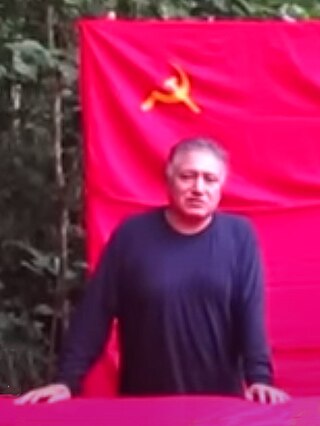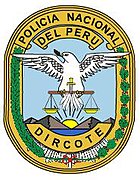
Manuel Rubén Abimael Guzmán Reynoso, also known by his nom de guerreChairman Gonzalo, was a Peruvian Maoist guerrilla leader and convicted terrorist. He founded the organization Communist Party of Peru – Shining Path (PCP-SL) in 1969 and led a rebellion against the Peruvian government until his capture by authorities in 12 September 1992. He was subsequently sentenced to life imprisonment for terrorism and treason.
Teniente FAP Jaime Montreuil Morales Airport is an airport serving Chimbote, in the Ancash Region of Peru. It is operated by the civil government and handles many government planes.

The Campo de Marte, also known as the Plaza de la Revolución, is a public park in Jesús María District, Lima, Peru. It is one of the largest parks in the metropolitan area of the city, and similar in size to the Park of the Exhibition and the Park of the Reserve. It was originally part of the Santa Beatriz area of Lima District and, from 1903 to 1938, housed the Santa Beatriz Hippodrome until its replacement by the one in San Felipe estate, located further south in the district.

The Civil Guard was the main preventive police force of Peru until its dissolution in 1988. As a national gendarmerie force, it was responsible for civil policing under the authority of the Ministry of the Interior, while investigative work was carried out by the Peruvian Investigative Police. It was also supported at times by the Republican Guard. During its dissolution process, it became known as the General Police until its formal integration into the National Police of Peru in 1991. The corps is colloquially known as the benemérita (reputable).

The National Police of Peru is the national police force of Peru. Its jurisdiction covers the nation's land, sea, and air territories. Formed from the merger of the Investigative Police, the Civil Guard, and the Republican Guard in 1988, it is one of the largest police forces in Latin America. Its mission is to preserve domestic order, public order and national security, in order to enforce the law and protect the people of Peru. The PNP is controlled by the Ministry of the Interior. The PNP has a number of divisions, tasked with enforcing specific aspects of the law; among the more well known are DIROES, DIRANDRO, DIRINCRI, and DIRCOTE (Anti-Terrorism).

Comrade José is a Peruvian communist militant, leader of the Militarized Communist Party of Peru, an offshoot of the Marxist–Leninist–Maoist guerrilla Shining Path. The group is present in the VRAEM region.

The Peruvian Investigative Police was a Peruvian plainclothes police unit, similar to the United States Federal Bureau of Investigation (FBI), which was meant to investigate crimes, gather intelligence, and fight subversion. In 1988, the PIP was merged into the National Police of Peru, along with two other police forces, the Guardia Civil (GC) and the Guardia Republicana (GR), all three of which were under the direction of the Ministry of Interior.

The National Directorate of Intelligence (Spanish: Dirección Nacional de Inteligencia), or (DINI), is the premier intelligence agency in Peru. The agency is responsible for national, military and police intelligence, as well as counterintelligence.

Luis Pércovich Roca was a Peruvian politician. Pércovich served as the President of the Congress of the Republic of Peru from July 1981 to July 1982. He served as Prime Minister of Peru from 14 October 1984 to 28 July 1985.

Luis Alberto Otárola Peñaranda is a Peruvian attorney and politician who was the Prime Minister of Peru from 2022 until his resignation in 2024. He previously served as Minister of Defense twice, under Ollanta Humala and Dina Boluarte.

Dina Ercilia Boluarte Zegarra is a Peruvian politician, civil servant, and lawyer currently serving as the President of Peru since 7 December 2022. She had served as the first vice president and minister at the Ministry of Development and Social Inclusion under President Pedro Castillo. She served as an officer at the National Registry of Identification and Civil Status (RENIEC) from 2007 until 2022.
Guillermo Bermejo Rojas is a Peruvian politician. He was elected for the Congress of Peru for the 2021-2026 period.

Following the ousting of president of Peru, Pedro Castillo on 7 December 2022, a series of political protests against the government of president Dina Boluarte and the Congress of Peru occurred. The demonstrations lack centralized leadership and originated primarily among grassroots movements and social organizations on the left to far-left, as well as indigenous communities, who feel politically disenfranchised. Castillo was removed from office and arrested after announcing the dissolution of Congress, the intervention of the state apparatus, and the establishment of an "emergency government", which was characterized as a self-coup attempt by some media organizations and institutions in Peru while Castillo's supporters said that Congress attempted to overthrow Castillo. Castillo's successor Dina Boluarte, along with Congress, were widely disapproved, with the two receiving the lowest approval ratings among public offices in the Americas. Among the main demands of the demonstrators are the dissolution of Congress, the resignation of Boluarte, new general elections, the release of Castillo, and the formation of a constituent assembly to draft a new constitution. It has also been reported that some of the protesters have declared an insurgency. Analysts, businesses, and voters said that immediate elections are necessary to prevent future unrest, although many establishment political parties have little public support.

The Ayacucho massacre was a massacre perpetrated by the Peruvian Army on 15 December 2022 in Ayacucho, Peru during the 2022–2023 Peruvian protests, occurring one day after President Dina Boluarte, with the support of right-wing parties in Congress, granted the Peruvian Armed Forces expanded powers and the ability to respond to demonstrations. The clash occurred due to the protesters' attempt to storm the local airport. On that day, demonstrations took place in Ayacucho and the situation intensified when the military deployed helicopters to fire at protesters, who later tried to take over the city's airport, which was defended by the Peruvian Army and the National Police of Peru. Troops responded by firing live ammunition at protesters, resulting in ten dead and 61 injured. Among the injured, 90% had gunshot wounds, while those killed were shot in the head or torso. Nine of the ten killed had wounds consistent with the ammunition used in the IMI Galil service rifle used by the army.

On 9 January 2023, Peruvian National Police shot at protesters in Juliaca during the 2022–2023 Peruvian political protests against President Dina Boluarte, resulting in a massacre. At least 18 people, including a medic responding to the scene, were killed and over 100 others were injured by police responding to protests in the city, with all of the deaths being attributed to gunshot wounds. The massacre was the deadliest day during the series of protests in Peru. Local media criticized the response of national media, saying that events in Juliaca were overlooked. The Inter-American Commission on Human Rights would describe the event, along with the similar killings in Ayacucho, as a massacre.

Vicente Romero Fernández is a retired general of the Peruvian National Police. He is the current Minister of the Interior of Peru since 13 January 2023 under the presidency of Dina Boluarte. He previously served as the Minister of the Interior under the presidency of Pedro Pablo Kuczynski from 9 January to 2 April 2018, after the resignation of Carlos Basombrío.

The United Democratic Andean Revolutionary Front of Peru (FUDARP) was an alliance between the Militarized Communist Party of Peru (MPCP) and the Plurinational Association of Tawantinsuyo Reservists (ASPRET) formed in 2017, with the objective of reconciling the two armed groups.
On December 6, 1988, Juan Carlos Vega Llona was assassinated one block away from the Peruvian embassy in the district of Cotahuma, La Paz, Bolivia, by armed members of the fictitious "Revolutionary Workers Movement", created in name by Shining Path, a Peruvian terrorist organisation. The murder of the embassy's naval attaché was carried out in reprisal for the Peruvian prison massacres that took place two years prior.
DIRCOTE Museum is a museum located in the premises of the National Directorate against Terrorism (DIRCOTE) on Spain Avenue in the historic centre of Lima, managed by the National Police of Peru and which exhibits objects seized from the Shining Path and Túpac Amaru Revolutionary Movement (MRTA) terrorist groups during the internal armed conflict that devastated Peru during the 1980s and 1990s.

The Special Intelligence Group was an elite unit of the National Police of Peru created within its National Directorate Against Terrorism with the purpose of locating and capturing the leadership bodies of terrorist groups operating since 1980: the Shining Path and the Túpac Amaru Revolutionary Movement.
















